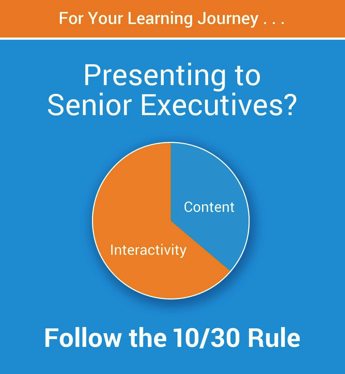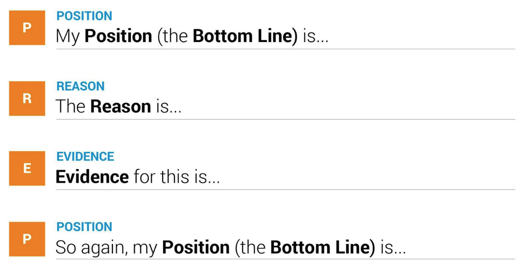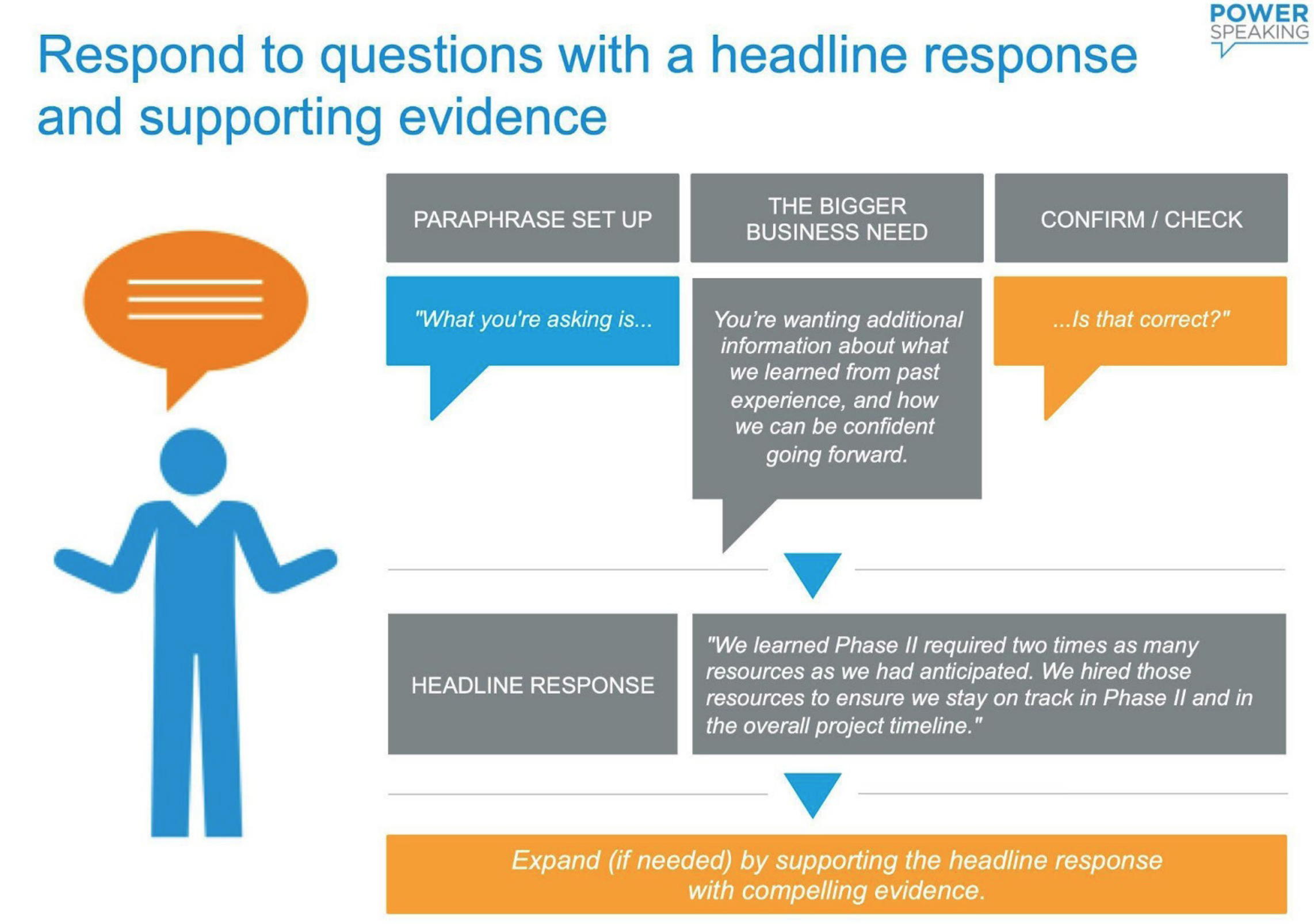.jpg?width=1254&name=23%20Tips%20Image%20Idea%209%20(1).jpg)
If you’re preparing to make a pitch to senior executives, you can throw most of what you’ve learned about making presentations in the trash.
Why? Because this is an entirely different audience. An executive presentation is not about inspiring and persuading, but is instead about presenting meaningful data to top decision-makers as quickly and concisely as possible. As a matter of fact, you should start with your bottom line (what you need from them). And work your way from there.
As a company that lives and breathes communication, we are dedicated to transforming your organization's communication skills, so you can watch people succeed at engaging and influencing others, achieving results, and driving business to new heights.
And today, we are going to reveal our favorite tips for a powerful executive presentation to decision-making leaders to help you get your point across efficiently, earn your audience’s attention, and know when and how to go in for the "ask."
So if you want more success from your business presentations, then you'll love this list of tips, techniques, and strategies.
Keep reading to get started with our tried and true tips!

Contents
Tip 1 Understand the executive mindset
Tip 2 Consider executives’ personality styles
Tip 3 Give yourself enough time to gather data
Tip 4 Find and leverage a sponsor
Tip 5 Prepare for possible questions or objections
Tip 7 Set the context and confirm the time slot
Tip 8 Use the PREP model if your time gets cut
Tip 9 State the outcome you want early
Tip 10 Always use a valid business reason
Tip 11 Follow with the essential data—and do a deep dive only if asked
Tip 12 Focus on analytical proof
Tip 13 Be proactive and transparent when delivering unpleasant news
Tip 14 Remember that executives want a dialogue—not a data dump
Tip 16 Use the Headline + Evidence model
Tip 17 Paraphrase complex questions to gain clarity
Tip 18 Address heated feedback and challenging questions in the moment
Tip 19 Answer the question-behind-the-question (before it is even asked)
Tip 20 Rely on the “notice and ask” strategy to refocus the discussion
Tip 21 Be personal to re-engage a disengaged executive
Tip 22 Acknowledge disagreements between top executives, but don't intervene
Tip 23 Conclude with a quick summary and resolve any noteworthy issues before your final ask
Let's dive right in.
Before you try to deliver your next presentation to executives, keep this in mind...
Most people fail with their first attempt to wow the top executives for one simple reason:
C-level executives demand an entirely different approach from presenters than does a general business audience. SVP of Strategy and Business Development at Workato, Markus Zirn says,
“You have to throw out everything you learned from traditional presentation training. It’s not about making a speech that educates, persuades, inspires, or leads. It’s about raw decision-making.”
With that little caveat out of the way, it’s time for our first strategy…
Tip 1
Understand the Executive Mindset
Executives are impatient, bottom-line-focused leaders who don't care about the minutiae of your project or expertise. They want you to get to the point, step away from your slide deck, and be ready for a dynamic dialogue.
During your presentation, they might multitask and switch topics quickly, make calculations in their heads at lightning speed, and they may be challenging when analyzing data. Be ready for this.
Understanding the executive's mindset as you are going in for the pitch will help you succeed. Watch the video below on Audience Analysis and getting started.
Here's just one executive you'll hear from...
"If it is a C-suite presentation and you’re actually asking for an outcome, you need to know what are the hot points of the CFO, or the treasurer’s office, or the VP of finance."
Tip 2
Consider executives’ personality styles
Think of each executive who will be in the room.
How do they prefer to have information presented to them? Where are they on the risk profile? Are they highly conservative, or are they innovative and open to experimentation? How will your proposal affect their areas of responsibility?
Starting with your audience in mind helps you strategize how to present your information.
Tip 3
Give yourself enough time to gather data
Weeks ahead of your presentation to executives, you may need to: meet with people in various functional areas for input and/or buy-in; check in with your manager; research executives’ hot buttons; and prepare slides or documents to send ahead. Don’t underestimate the time it will take to do all of this.
And speaking of being prepared, make sure you’ve considered the environment in which you’ll likely be with them—namely, virtual. If presenting to executives weren’t challenging enough, today’s digital interactions present another layer of things to consider.
Check out this great article, “Digital Communication Skills: Is Your Message Getting Across?,” by digital presenting and training guru Cindy Huggett. Great suggestions not only for putting your best digital self forward with senior executives, but also tips you can use in any virtual-meeting situation.
Tip 4
Find and leverage a sponsor
Find someone who knows the group you’re presenting to who is willing to not only help you prepare as your guide, but can also advocate for you during the meeting. Use your sponsor to check the validity of your logic ahead of time, rehearse with and get feedback from, and agree on when you should look to them for help during the executive meeting.
Debrief with your sponsor after the meeting to gain insights and lessons you can use in the future.
Tip 5
Prepare for possible questions or objections
Consider including a slide that states the answers to anticipated questions or concerns rather than waiting for them to be brought up. This is a great way to demonstrate that you’ve kept your audience in mind when preparing your presentation.
Tip 6
Follow the 10/30 Rule
If you have 30 minutes on the executives’ meeting agenda, plan to present 10 minutes of material. The remainder of the time will likely be devoted to discussion and interaction and not necessarily in sequence.
Remember that your role is to facilitate a conversation, not just deliver a presentation.

Tip 7
Set the context and confirm the time slot
You don’t need an entertaining, attention-getting opening, but you do need to set the context as you start and get an agreement on timing. Thirty minutes originally may have been planned, but the meeting timeline can change.
Start by saying, “I understand we have scheduled 30 minutes. Does that timing still work?”
Rajeev Goel, Co-Founder and CEO at PubMatic, and Monica Poindexter, Vice President, Inclusion & Diversity/Employee Relations at Lyft, will give you tips on overcoming the presentation challenges in regards to context.
Tip 8
Use the PREP model if your time gets cut
Don’t be surprised if what you thought would be a 30-minute meeting is cut to 10 minutes because the executives have another more urgent matter to discuss. Use the “PREP” model to craft your abbreviated pitch before the meeting:

Tip 9
State the outcome you want early
State the outcome you want from your presentation early. What do you want the executives to say “yes” to?
Be specific. For example, “I want your support” is vague. “I want you to approve a $500,000 investment in new centrifuge equipment this quarter” is specific.
Get that key message out first...
Tip 10
Always use a valid business reason
Clearly state what value or ROI your ask will bring in terms of revenue increase, cost reduction, protection from risk, competitive advantage, or other business drivers. It can’t be just a “nice to have” proposal.
For example...
“The bottom line is, we’re seeking your approval for five new FTEs in account management roles for an investment of $750,000. The reason is that we have a $2M revenue opportunity with the launch of [XYZ project]. These account managers will focus on the top 20% of our customer base to ensure we maximize the sales opportunity.”
Tip 11
Follow with the essential data—and do a deep dive only if asked
Instead of drowning listeners in data, lead with the top two to three key points and supporting evidence that best support your ask and business reason. The key points should be answers to the primary questions you think the executives will have about your proposal.
Keep in mind that execs want the 10,000-foot view and how it affects the organization's bottom line.
Tip 12
Focus on analytical proof
Senior decision-makers don’t need to be entertained. So while your logic may follow a “storyline,” hard data is what will be more convincing.
If you have a customer success story or a brief anecdote that supports your point, use it. But remember, unlike a general audience, the C-level executives in the room will grow impatient with stories unless they’re succinct and tie directly to your proposal.
Tip 13
Be proactive and transparent when delivering unpleasant news
There are four steps to presenting bad news:
- Get it out at the beginning
- Be candid about what happened
- Explain how you will fix it
- Offer options and recommendations.
You can use this 4-step framework to present bad news in a way that speaks to executives.
Let's take a look at a hypothetical example. You have to explain to them why a consultant they hired quit, and you need to rectify the situation...
1. Get it out at the beginning
The consultant you approved quit unexpectedly. A response to the audit she was supposed to help us with is due next week. Today I want to talk about the path forward.
2. Be candid and explain how you will fix the situation
By the end of this meeting, I’d like your approval to:
-
Respond to the audit in a generic way with help from the audit team
-
Collaborate with the internal process improvement team to assess our local processes
-
Collaborate with my counterpart to create one agreement that combines the best aspects of our process and theirs
3. Offer options on why it makes business sense
-
No additional cost of hiring a consultant
-
We’ll be able to leverage the existing processes to create a process that is consistent across the globe
4. Offer final recommendations
With all of that in mind, today I’d like to talk about how we should change our audit process and why I’m confident this plan will receive regulatory approval.
Is there anything else you’d like me to add?
If you have bad news, don’t try to gloss over it. Use the framework to present it in a way that speaks to executives.
Tip 14
Remember that executives want a dialogue—not a data dump
Expect questions and energetic discussions to occur before you have presented all of your material.
(Remember the 10/30 Rule: If you have 30 minutes, prepare only 10 minutes’ worth of “presentation.”) Respond to questions when they come up.
Use facilitation skills to refocus the discussion after a topic change.
Here are a few more tips to enhance your facilitation skills:
Tip 15
Read the room
Notice the process of the discussion as well as the content. When there is cross-talk, interruptions, or rapid-fire questions, you can observe first and then choose an appropriate intervention.
Reading the room can be especially challenging in virtual meetings. You want to encourage everyone to turn on their webcam. Solicit feedback via chat. Stop the presentation and do a quick “reality check” if you notice disengagement or tension.
Tip 16
Use the Headline + Evidence model
Again, this is a time-pressed audience that wants brief, focused answers to their questions. Use the “Headline Response” model to help you do just that.

Tip 17
Paraphrase complex questions to gain clarity
Instead of restating an executive’s question verbatim, use synonyms when you paraphrase.
Remember, you don’t know what is on someone’s mind. So, always check for accuracy after paraphrasing. “Did I get that right?” or just “Right?” gives the questioner a chance to agree or disagree. If your understanding wasn’t accurate, try again.
Tip 18
Address heated feedback and challenging questions in the moment
Especially if someone is upset, a deeper level of listening is required. Reflect on both the content and the feeling you noticed (skeptical, concerned, frustrated, etc.) and answer the question as best you can.
Always check to see if you got it right. Never say, “I know how you feel,” because you don’t, actually.
Tip 19
Answer the question-behind-the-question (before it is even asked)
If you get resistance or objections to your ideas, often executives are concerned with key business drivers such as top-line and bottom-line impact, competitive positioning, and risk management.
When you paraphrase their questions, check for these concerns and be ready to address them directly.
Listen for the question-behind-the-question.
Tip 20
Rely on the “notice and ask” strategy to refocus the discussion
You are not in a position to tell the executives what to do.
But if the discussion goes in a different direction, you can say, “I notice our discussion is now focused on X. May I get your guidance? Would you like to keep going in this direction, or would you like to go back to our topic?”
Tip 21
Be personal to re-engage a disengaged executive
You don’t want to catch anyone off guard, so give a little context when you ask someone directly for their thoughts (as a re-engagement strategy).
For example, “Jaime, given that what we are trying to do here is to reduce response time, in your experience, will this new approach work in the field?”
Tip 22
Acknowledge disagreements between top executives, but don't intervene
You may look to your sponsor to help calm things down, but don’t intervene.
Tip 23
Conclude with a quick summary and resolve any noteworthy issues before your final ask
As you end your presentation, summarize and check to be sure you are clear on what decisions or agreements have been made and what your next steps will be.
“I explained x and y; you also brought up a and b. Do I have your go-ahead now to purchase the new equipment for $500,000 this quarter?”
Presenting to senior executives is often a nerve-wracking, high-stakes situation. But as these leaders will tell you, it can be a great opportunity to grow, and to increase your value to the organization.
Conclusion
I hope you’ve found these tips enlightening and helpful. Learning to think like senior executives and present to them means learning new habits—and breaking old ones. But wow, I know it’s hard. And we present a lot of information to take in with our 23 Tips.
So, here’s one final piece of advice: start small. Pick one or two tips to apply to your next presentation. And check out this quick-read article, “4 Steps to Making New Habits Stick,” by Cindy Solomon, founder, and CEO of the Courageous Leadership Institute. It will help you learn how to make the most of small steps toward new habits.
But before you get started using them for your next presentation, I’d like to hear from you.
Which presentation tip from this list was your favorite?
...Or maybe you have a suggestion that I didn't cover here?
Either way, let me know by leaving a comment below.
Join Us in Conversation . . .

From Anxious to Authentic: Unlock the Joy of Small Talk
Thursday, December 18, 2025, 9:00-10:00 a.m. PT; 12:00-1:00 p.m. ET; 5:00-6:00 p.m. BST
.png)
CEO Carrie Beckstrom's expert guests:
Susan RoAne
Keynote Speaker and Author








